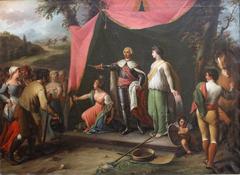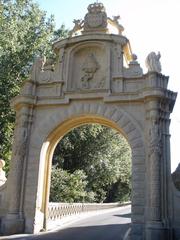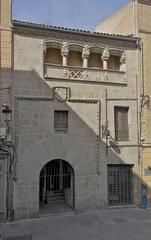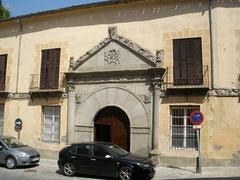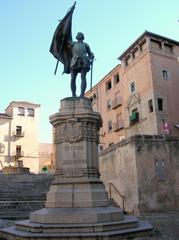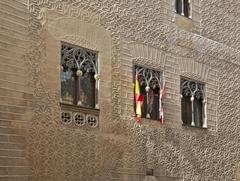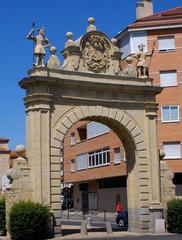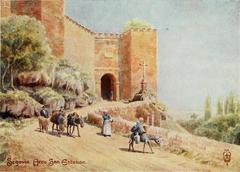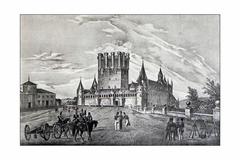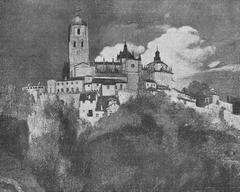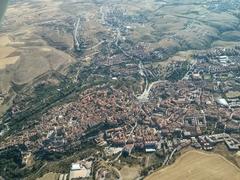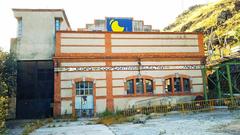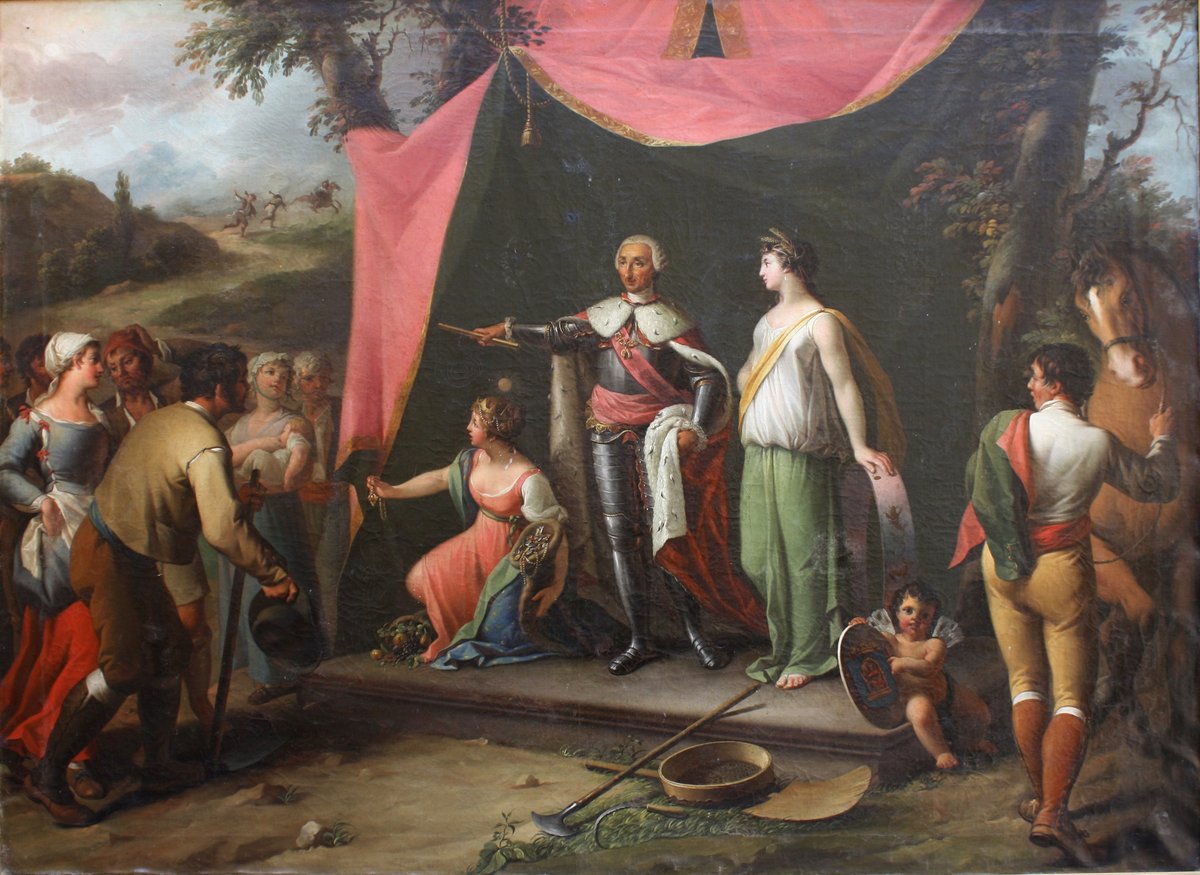
Alcázar of Segovia: Visiting Hours, Tickets, and Historical Significance
Date: 14/06/2025
Introduction
The Alcázar of Segovia is one of Spain’s most celebrated historical landmarks, instantly recognizable for its fairy-tale silhouette and commanding location atop the confluence of the Eresma and Clamores rivers. Over a millennium old, this fortress has served as a military stronghold, royal palace, and symbol of Castilian power, welcoming monarchs such as Queen Isabella I and Christopher Columbus. Today, it stands as a museum and military archive, offering visitors a captivating journey through Spain’s royal, military, and architectural history (Fearless Female Travels, Patrimonio Nacional, Wikipedia, Segovia Tourism).
This comprehensive guide covers the Alcázar’s historical evolution, architectural highlights, practical visitor information, nearby attractions, and tips to ensure a memorable visit to this UNESCO World Heritage Site.
Table of Contents
- Historical Overview
- Architectural Significance
- Visitor Information
- Nearby Attractions
- Frequently Asked Questions
- Visuals and Media
- Conclusion
- Sources
Historical Overview
Early Origins and Strategic Foundations
The name “alcázar” derives from Arabic “al-qaṣr,” meaning fortress or palace, a testament to the region’s Islamic past. While the earliest documentary evidence dates to the 12th century, archaeological findings suggest even earlier fortifications, possibly during Muslim rule. The castle’s location atop a rocky outcrop at the rivers’ meeting point provided a formidable defensive advantage (Explorial, Wikipedia).
Royal Residence and Castilian Power
King Alfonso VIII transformed the Alcázar from a military outpost into a royal residence in the late 12th century. Over the following centuries, it became the seat of at least twenty-two Castilian kings. Queen Isabella I was proclaimed queen here in 1474, and Christopher Columbus is said to have visited during his campaign for royal patronage (Itinerartis, The Tour Guy).
Architectural Evolution
The Alcázar’s architecture is a blend of Romanesque, Gothic, Mudéjar, and Renaissance styles. Notable features include the Tower of John II (Torre de Juan II), the Hall of Kings with its frieze of monarchs, and lavishly decorated halls and chapels. A major fire in 1862 prompted significant restoration, culminating in the mid-20th century reopening as a public museum (Fearless Female Travels).
Multifaceted Roles Through the Ages
In addition to its royal and defensive uses, the Alcázar has served as a state prison, the Royal Artillery College, and, since 1998, houses the General Military Archive of Segovia (Wikipedia).
Architectural Significance
Style Evolution
The Alcázar exemplifies Spain’s architectural syncretism from the 12th to 16th centuries. Its Romanesque base, Gothic additions under Alfonso VIII, Mudéjar decorative arts, and Renaissance embellishments after the 1862 fire reflect successive eras of craftsmanship (Patrimonio Nacional, Segovia Tourism, Spain.info).
Defensive Features
The fortress stands on a triangular plan with the Torre de Juan II at its apex. Defensive elements include a moat, drawbridge, fortified gatehouse, thick stone walls, arrow slits, and battlements. The 80-meter-high Torre de Juan II, accessible via a spiral staircase, offered panoramic surveillance and remains a highlight for visitors (Atlas Obscura).
Symbolism and Royal Authority
The Alcázar was designed to impress dignitaries and communicate royal legitimacy. The Hall of Kings displays a frieze of 52 monarchs, and the Throne Room’s gilded ceiling features the Catholic Monarchs’ motto. Its iconic silhouette is believed to have inspired Walt Disney’s Cinderella Castle (Smithsonian Magazine).
Interior Artistry
The interiors showcase period tapestries, armory, and furniture, with the Hall of the Galley’s ship-hull–shaped Mudéjar ceiling and the Gothic chapel among the artistic highlights (Segovia Tourism).
Preservation and Restoration
Following the 1862 fire, architect Antonio Bermejo y Arteaga led restoration efforts, combining historical fidelity and modern safety. Ongoing conservation is overseen by the Board of Trustees of the Alcázar of Segovia (Patrimonio Nacional).
Influence on Castle Design
The Alcázar’s blend of fortification and residential luxury set a precedent for later Spanish castles. Its slate roofs and conical turrets have influenced both Spanish and European castle architecture (Spain.info).
Notable Features
- Tower of John II: 80 meters high, panoramic views
- Moat and Drawbridge: Reflecting medieval defenses
- Hall of Kings: Unique royal frieze
- Mudéjar Ceilings: Masterful Islamic-inspired craftsmanship
- Chapel: Gothic arches and stained glass
Visitor Information
Visiting Hours
- Winter (November–March): 10:00 AM – 6:00 PM
- Summer (April–October): 10:00 AM – 8:00 PM
- Closed Mondays except public holidays; last entry 30 minutes before closing (alcazardesegovia.com).
Tickets and Pricing
- General Admission: Approx. €12
- Reduced Admission: For EU citizens aged 18–25 and seniors over 65
- Free Entry: Children under 18, Segovia residents, certain holidays
- Tower Access: Included with full ticket; 152-step climb
- Group Tickets: Available for schools and professionals (advance booking required)
- Accredited Guides: Free reconnaissance tickets available upon documentation
Advance online purchase is strongly recommended due to limited capacity (alcazardesegovia.com).
Accessibility
- Main palace and museum areas are accessible
- The Tower of Juan II and some staircases are not accessible for visitors with reduced mobility
- Consult staff or the official website for specific needs
Guided Tours and Audio Guides
- Tours in multiple languages; book in advance for groups
- Audio guides and mobile apps available for self-guided exploration
Travel and Parking
- Getting There: Segovia is accessible via AVE high-speed train from Madrid (30 minutes), with local buses and taxis from Segovia-Guiomar station to the historic center
- On Foot: The Alcázar is a 15–20-minute walk from the Aqueduct or Cathedral through the old town
- Parking: No onsite parking; limited street parking nearby in “zona verde” (expensive, time-limited) and “zona azul.” Free on Saturday afternoons and Sundays, but spaces fill quickly
Visitor Regulations
- No eating or drinking inside
- Flash photography and tripods restricted in sensitive areas
- Large bags must be checked; cloakroom available
- Quiet is requested, especially for group visits
- Only service animals allowed
Nearby Historical Attractions
- Roman Aqueduct: Iconic 1st-century engineering marvel at Plaza del Azoguejo
- Segovia Cathedral: Late Gothic masterpiece on Plaza Mayor, 88-meter bell tower
- Jewish Quarter: Medieval streets, synagogues, and the Centro Didáctico de la Judería
- Mirador de la Pradera de San Marcos: The best viewpoint for photographing the Alcázar at sunset
- Museo de Segovia (Casa del Sol): Artifacts from Roman to Renaissance eras
- Iglesia de San Millán: 12th-century Romanesque church
- Plaza Mayor and Plaza de Medina del Campo: Social hubs with Renaissance architecture
- City Walls and Puerta de San Andrés: Remnants of Segovia’s medieval fortifications
- Pedraza: Medieval village perfect for a half-day trip
Frequently Asked Questions (FAQ)
Q: What are the Alcázar’s opening hours?
A: 10:00 AM – 6:00 PM in winter; 10:00 AM – 8:00 PM in summer. Closed Mondays except holidays.
Q: How much does admission cost?
A: General admission is €12, with discounts for certain groups and free entry for children under 18.
Q: Is the Alcázar accessible for visitors with disabilities?
A: The main areas are accessible, but the tower and some sections have limited access.
Q: Are guided tours available?
A: Yes, in multiple languages; book in advance for best availability.
Q: Can I take photographs?
A: Yes, but no flash or tripods in sensitive areas.
Q: Are combination tickets offered for other attractions?
A: Sometimes, check online for current offers.
Q: Are pets allowed?
A: Only service animals are permitted.
Q: How long should I plan for my visit?
A: Allocate 1.5–2 hours; longer if including tours or museums.
Visuals and Media
- Exterior Photo: “Alcázar of Segovia castle exterior with blue sky”
- Aqueduct Image: “Roman Aqueduct of Segovia arches at Plaza del Azoguejo”
- Cathedral Interior: “Stained glass windows inside Segovia Cathedral”
- Viewpoint: “View of Alcázar of Segovia from Mirador de la Pradera de San Marcos at sunset”
High-quality images with descriptive alt texts enhance the visitor experience and support SEO.
Conclusion
The Alcázar of Segovia is a living testament to Spain’s royal ambition, military ingenuity, and architectural splendor. Its unique blend of styles, strategic setting, and pivotal role in history make it an essential destination for travelers and history enthusiasts alike. With well-organized visitor services, engaging tours, and easy access to Segovia’s other UNESCO treasures, the Alcázar offers a rich and memorable journey into Spain’s past.
For the latest updates, events, and visitor tips, consult the official website, download the Audiala app, and explore Segovia’s many historical wonders.
Sources and Further Reading
- Fearless Female Travels
- Patrimonio Nacional
- Official Alcázar of Segovia Website
- Wikipedia
- Explorial
- The Tour Guy
- Segovia Tourism
- Spain.info
- Atlas Obscura
- History Tools
